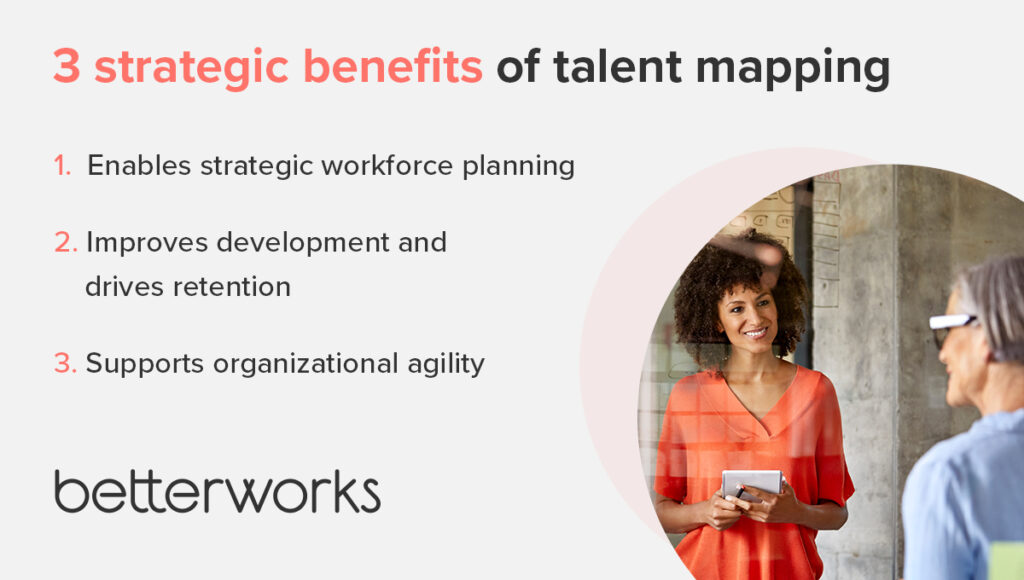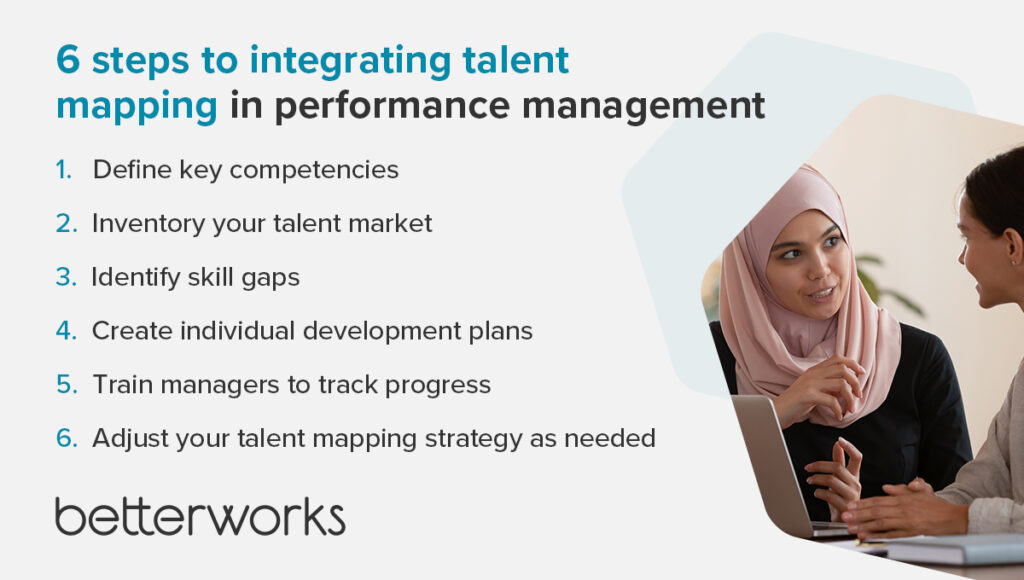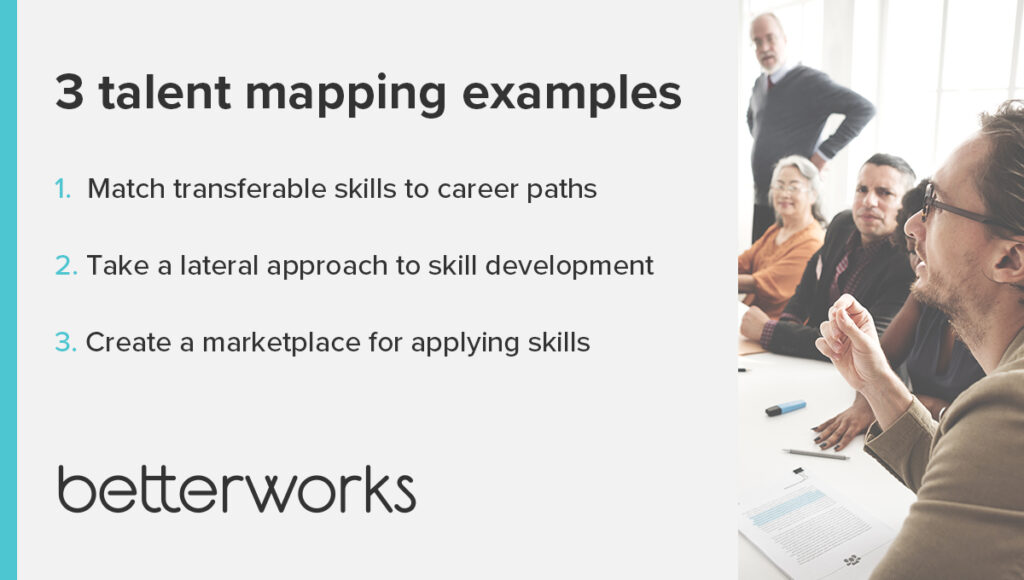Unlocking the full potential of your organization’s talent requires a deliberate, planned approach to placing employees where they can create the most impact. Talent mapping — the art of strategically aligning skills, aspirations, and potential — is a crucial component for HR leaders building a high-performing workforce.
By charting the course for your employees’ career paths, identifying their unique strengths, and mapping development opportunities, you can put your workforce in a position to drive innovation and growth.
Discover the power of an effective talent mapping process and how it can revolutionize your organization’s talent management strategy.
What is talent mapping?
Talent mapping, a key element of talent management, refers to the strategic process of identifying and analyzing the workforce’s skills, capabilities, and potential so you can place employees in roles where they best support the business strategy. Talent mapping involves a comprehensive assessment of employees’ skills, experiences, and growth potential. This process helps HR leaders understand the organization’s talent landscape. Conducting such an assessment reveals existing skills and workers’ potential to develop new skills and take on more challenging roles.
By aligning employees’ talents with the organization’s strategic goals, HR can strategically place people in positions where they contribute most effectively to the success of the business. Effective talent mapping maximizes your existing workforce and identifies skill gaps and areas for development. From there, HR can implement targeted training and development programs to bridge the gaps and enhance the workforce’s overall capabilities.
3 strategic benefits of talent mapping
Talent mapping is a strategic approach to your workforce that helps HR leaders identify and improve skill sets through the lens of business strategy. Here are three key benefits of talent mapping for your business.
Enables strategic workforce planning
Talent mapping allows HR leaders to identify and plan for future talent needs based on business strategy. It helps with identifying and forecasting skill gaps, as well as securing the right kinds of talent when you need them most.
By mapping your workforce’s skills and potential, talent mapping also improves succession planning. This process helps identify high-potential employees in need of leadership development. Talent mapping helps companies create a deep bench of leadership talent and ensure continuity for critical roles.
In a high-growth business, meanwhile, you’ll need to identify and fill new roles as you expand. By assessing in-house skills and capabilities, you can determine where cross-training employees will fill these roles and where you need to make an external hire.
Improves development and drives retention
Talent mapping helps organizations understand each employee’s skills and aspirations so they can design targeted talent development programs.
Talent mapping matches skill sets with roles in the organizational chart, which can help you fill gaps and offer lateral advancement opportunities to employees whose skills fit well in another role. Employees who receive this training and development will get a better picture of how they can advance. They’ll feel a greater sense of purpose at work, see how they make a tangible contribution to business outcomes, remain engaged, and stay on longer.
Supports organizational agility
Talent mapping helps organizations quickly identify and mobilize talent to address emerging business needs and opportunities.
In today’s business climate, your needs can change rapidly. When you can visualize your workforce’s capabilities at a glance, you can make better decisions about where to place talent for quick wins — and where to develop talent for emerging needs.

6 steps to integrating talent mapping in performance management
When organizations combine talent mapping with continuous performance management processes, they align talent development with business strategy. These organizations can make targeted development interventions to give employees the skills and competencies that drive organizational success.
Here are six steps to integrating talent mapping into your performance management processes.
Define key competencies
Identify the key competencies and skills required for each role within the organization. These competencies should align with the organization’s strategic goals and objectives. Make sure you can describe each role’s impact on the business. If you haven’t reviewed your job descriptions in more than a year, reexamine them to see whether they’re still aligned.
Inventory your talent market
There are many ways to assess your workforce’s skills, capabilities, and potential. These metrics include performance data, manager and peer feedback, calibration data, and skills assessments. Bring his data together to obtain a comprehensive view of your employee population’s talent.
Identify skill gaps
Compare your workforce’s assessed skills and competencies with the required competencies for each role. From there, identify skill gaps or areas for development.
Bring managers into this process, since they’re closest to employees and can provide a better picture of their potential and development needs. As managers record performance conversations with their reports, they’ll generate valuable data for assessing and addressing skills gaps.
Create individual development plans
Based on talent assessments and identified skill gaps, create individual development plans for each employee. These plans should outline the actions, training programs, or experiences that will help them develop the required skills and competencies.
Consider each employee’s career aspirations, too. Successful talent mapping requires engaged employees who are actively growing and working toward their career development goals.
Train managers to track progress
Managers should already have regular check-ins with their reports that include progress reports on performance and goals. Make sure talent mapping processes are part of these conversations, too. Managers should be ready to assess employees’ efforts to close skill gaps, offer constructive feedback, and adjust development plans as needed.
Adjust your talent mapping strategy as needed
HR leaders should monitor talent mapping exercises to ensure they produce the skill sets the organization needs to achieve business goals. Regularly review performance data, including from manager-employee conversations, to identify persistent talent gaps and provide additional support where needed.

5 elements to include in a talent mapping template
Talent mapping templates take many forms, but they usually include information on employee skills, experiences, and performance ratings, as well as potential for growth and development.
Here are some common elements to include in your talent mapping template.
Skills and competencies by job title and role
Identify the essential skills and competencies required for each job title or role within the organization. By developing clear, consistent qualifications for each job role and title, you can fairly assess employees’ capabilities and fit for any particular position. Having clear job competencies and skills can also help with external hiring decisions.
Skills and competencies by employee
In your talent mapping template, highlight each employee’s unique skills and potential. In enterprise organizations, the number of employees can easily become overwhelming. Consider assessing employees across specific locations or looking at a particular role. Compare, for example, the skills required for a customer service position against the most common skills of employees in such roles.
From there, you can filter employees whose skills match and map them to development opportunities. This process applies to entry-level employees all the way to high-potential leadership candidates in your succession planning pipeline.
Succession planning needs
Within your template, identify succession planning needs. Include the roles that are mission-critical to maintaining business continuity. Match high-potential candidates to specific leadership roles or functions.
Recruitment needs
Talent mapping helps you identify career paths for employees so they can deliver the biggest impact for the organization. But not every need can be filled from within. When you use talent mapping, the recruiting process becomes easier because you know exactly what skills you need to open requisitions. Talent acquisition is driven by a need for specific skills, limiting unnecessary headcount increases.
Development opportunities
The talent mapping template should include each employee’s high-priority needs and the development plan to address them.
Mapping skills to development opportunities: 3 talent mapping examples
Assessing skills data and identifying gaps is only part of the talent mapping process. You also need to help your employees fill those gaps through development opportunities. Here are three examples of this process in action.
Match transferable skills to career paths
Identify the key transferable skills required for internal career paths. Use that knowledge to create job rotations, cross-functional projects, and mentorship programs that provide employees with practical opportunities to develop those skills.
Take a lateral approach to skill development
Career growth isn’t always a ladder. Help employees move laterally, especially when promotional opportunities are scarce. Talent mapping helps employees understand where their skills are a good fit within the company, even if that’s in a different role or department than they currently work. Encouraging nonlinear career paths helps HR and managers fill talent gaps while helping employees visualize a range of career options.

Create a marketplace for applying skills
One of the more flexible ways to use top talent to its full potential is to create an internal talent marketplace where employees with specific skill sets can pick up “gigs” in other departments or teams. This helps your organization fill skill needs without having to hire additional full-time employees or turn to contractors.

Take talent mapping to the next level
In today’s competitive business landscape, organizations must use talent management as a strategic driver. Talent mapping is a crucial component of a business-first talent management strategy that primes your entire workforce to grow, develop, and innovate.
Want to learn more? Check out our guide to talent management frameworks.
Keep your workforce’s skills up to date


